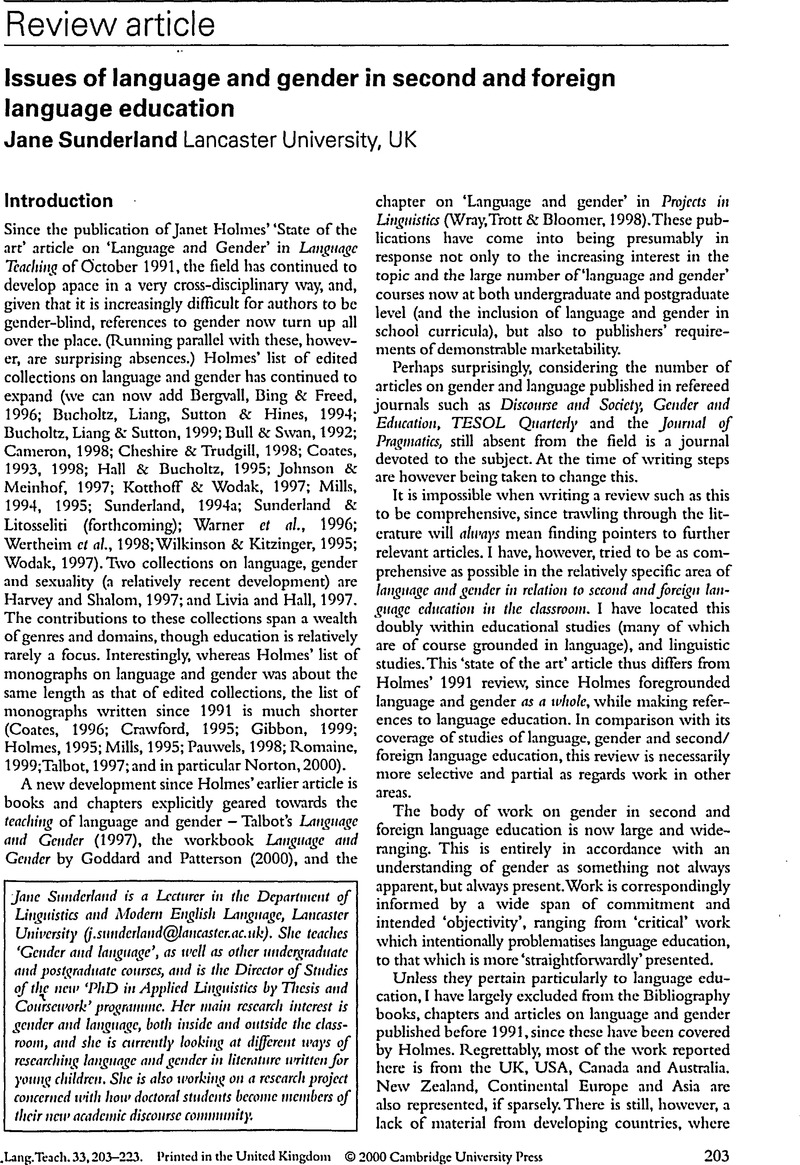Crossref Citations
This article has been cited by the following publications. This list is generated based on data provided by Crossref.
Gu, Yongqi
2002.
Gender, Academic Major, and Vocabulary Learning Strategies of Chinese Efl Learners.
RELC Journal,
Vol. 33,
Issue. 1,
p.
35.
Kubota, Ryuko
2003.
New approaches to gender, class, and race in second language writing.
Journal of Second Language Writing,
Vol. 12,
Issue. 1,
p.
31.
Ulrich, Sabine
2003.
Mutualisation des expériences dans l'enseignement des langues dans les IUFM.
Tréma,
p.
161.
Baurens, Mireille
2006.
Différenciations sexuées en classes de langues-cultures : palimpseste du genre, nouvelle friche pour la didactologie des langues-cultures.
Éla. Études de linguistique appliquée,
Vol. 142,
Issue. 2,
p.
239.
Piller, Ingrid
and
Pavlenko, Aneta
2006.
The Handbook of Bilingualism.
p.
489.
Lai, Mee-Ling
2007.
Gender and Language Attitudes: A Case of Postcolonial Hong Kong.
International Journal of Multilingualism,
Vol. 4,
Issue. 2,
p.
83.
Breland, Hunter
and
Lee, Yong-Won
2007.
Investigating Uniform and Non-Uniform Gender DIF in Computer-Based ESL Writing Assessment.
Applied Measurement in Education,
Vol. 20,
Issue. 4,
p.
377.
Han, Huamei
2007.
Language and Religious Identity.
p.
196.
Pavlenko, Aneta
2008.
Encyclopedia of Language and Education.
p.
3365.
Baroni, Raphaël
and
Jeanneret, Thérèse
2008.
Parcours de vie, identités féminines et trajectoires d'apprentissage.
Langage et société,
Vol. n° 125,
Issue. 3,
p.
101.
Tse, Polly
and
Hyland, Ken
2008.
‘Robot Kung fu’: Gender and professional identity in biology and philosophy reviews.
Journal of Pragmatics,
Vol. 40,
Issue. 7,
p.
1232.
Pavlenko, Aneta
and
Piller, Ingrid
2008.
Encyclopedia of Language and Education.
p.
57.
Appleby, Roslyn
2009.
The spatial politics of gender in EAP classroom practice.
Journal of English for Academic Purposes,
Vol. 8,
Issue. 2,
p.
100.
Wu, Hui-Ying
and
Hsu, Hsin-Piao
2009.
Performance of University students on English reading and writing when using a Web 2.0 tool.
p.
681.
Park, Deok-Jae
2009.
Cognition of Teachers' and Students' Awareness on Gender for the Contents of Korean Language Education.
The Journal of the Korea Contents Association,
Vol. 9,
Issue. 8,
p.
423.
Gómez, Antonio García
2010.
Gender Perspectives on Vocabulary in Foreign and Second Languages.
p.
238.
Espinosa, Soraya Moreno
2010.
Gender Perspectives on Vocabulary in Foreign and Second Languages.
p.
139.
Fontecha, Almudena Fernández
2010.
Gender Perspectives on Vocabulary in Foreign and Second Languages.
p.
93.
Sunderland, Jane
2010.
Gender Perspectives on Vocabulary in Foreign and Second Languages.
p.
1.
POMERANTZ, ANNE
and
BELL, NANCY D.
2011.
Humor as Safe House in the Foreign Language Classroom.
The Modern Language Journal,
Vol. 95,
Issue. s1,
p.
148.





